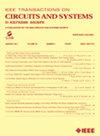A 1.46-pJ/bit, 149-KF² RO TRNG Based on Reference-RO-Free Thresholding of Jitter Accumulation
IF 4.9
2区 工程技术
Q2 ENGINEERING, ELECTRICAL & ELECTRONIC
IEEE Transactions on Circuits and Systems II: Express Briefs
Pub Date : 2025-02-19
DOI:10.1109/TCSII.2025.3543628
引用次数: 0
Abstract
In this brief, a ring-oscillator-based true random number generator (RO-TRNG) is presented with an energy-efficient on-chip module for temporal thresholding of the accumulated jitter noise. The need of power-hungry reference ring oscillator (RO) for frequency collapse detection in previous implementation can be completely removed. In addition, by setting the RO-TRNG’s enable signal adaptively according to the output of the proposed jitter accumulation thresholding (JAT) module, the redundant oscillations in most cycles of the prior art can be fully eliminated, leading to significant energy saving per each TRNG bit. Based on a 65-nm 1.2 V standard CMOS process, the fabricated TRNG chips feature an ultra-compact silicon area of 149 K基于无参比RO累积阈值的1.46 pj /bit、149 kf²RO TRNG
本文提出了一种基于环形振荡器的真随机数发生器(RO-TRNG),该发生器具有高效的片上模块,用于累积抖动噪声的时间阈值处理。在以前的实现中,需要耗电的参考环振荡器(RO)进行频率崩溃检测,可以完全消除。此外,通过根据所提出的JAT模块的输出自适应地设置RO-TRNG的使能信号,可以完全消除现有技术中大多数周期中的冗余振荡,从而实现每个TRNG比特的显著节能。基于65纳米1.2 V标准CMOS工艺,制造的TRNG芯片具有超紧凑的硅面积为149 K $F^{2}$。同时,原型芯片在1.0 V的电源电压下实现了1.46 pJ/bit的高能效,总吞吐量为44.7 Mbps。采用美国国家标准与技术研究院(NIST)和自相关函数(ACF)测试工具验证了所制TRNG芯片的高随机性。此外,在- 40°C~125°C的工业温度范围和1.0 V~1.4 V的电源电压范围下,TRNG芯片的Shannon熵值超过0.999998,表现出对工艺电压温度(PVT)变化的良好耐受性。
本文章由计算机程序翻译,如有差异,请以英文原文为准。
求助全文
约1分钟内获得全文
求助全文
来源期刊
CiteScore
7.90
自引率
20.50%
发文量
883
审稿时长
3.0 months
期刊介绍:
TCAS II publishes brief papers in the field specified by the theory, analysis, design, and practical implementations of circuits, and the application of circuit techniques to systems and to signal processing. Included is the whole spectrum from basic scientific theory to industrial applications. The field of interest covered includes:
Circuits: Analog, Digital and Mixed Signal Circuits and Systems
Nonlinear Circuits and Systems, Integrated Sensors, MEMS and Systems on Chip, Nanoscale Circuits and Systems, Optoelectronic
Circuits and Systems, Power Electronics and Systems
Software for Analog-and-Logic Circuits and Systems
Control aspects of Circuits and Systems.

 求助内容:
求助内容: 应助结果提醒方式:
应助结果提醒方式:


